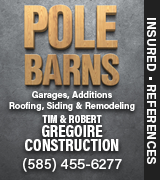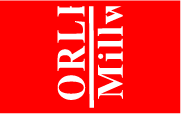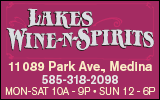Medina unveils interpretive panel about community’s role with Underground Railroad
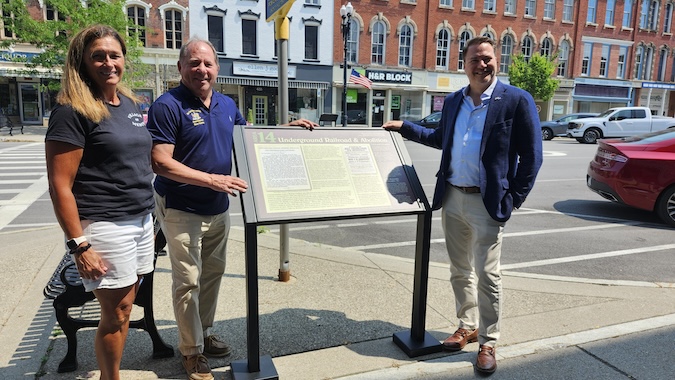
Photos by Ginny Kropf: Village of Medina Mayor Marguerite Sherman stands with Assemblyman Steve Hawley, left, and State Senator Rob Ortt at the unveiling Monday of an interpretive panel detailing Medina’s involvement in the Underground Railroad. Hawley and Ortt funded the panel, which stands by the historic sign for Frederick Douglass in front of Main Street TV and Appliance.
MEDINA – A new piece of history was unveiled in Medina on Monday afternoon, with the dedication of an interpretive panel detailing Medina’s involvement in the Underground Railroad.
“Medina residents have long been intrigued about their community’s contribution to the Underground Railroad,” said Chris Busch, president of Orleans Renaissance Group, whose efforts resulted in installation of the panel. “There are many examples of local lore and legend regarding area homes with odd architectural features, that were rumored to have been used to help escaped slaves – but none of these stories were substantiated. For myself, a former village historian and Social Studies teacher, this has always been a topic of great interest. That’s why a letter in the New York Daily Tribune on June 29, 1854 is so important. It confirms without a doubt that Medina’s citizens played a role.”
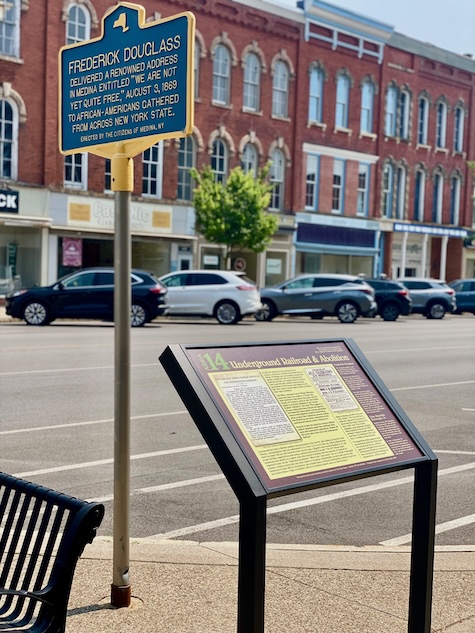
The new panel is next to a historical marker unveiled in 2015 that noted famed abolitionist Frederick Douglass gave two speeches in Medina.
The article mentions a chattel who arrived by Underground Railway in the village of Medina, N.Y. from Richmond, Va. The article tells of his destitute condition and how he sat in the home of a friend.
It continues to read, “And while darkness still held the portals of the East on sabbath morn, he set out, accompanied with a friend, for his prospective home in Canada, where we rejoice to know, he safely arrived on Sunday evening.”
The panel explains, “All over the North the news was the same. A fugitive slave reached Medina, N.Y.; the people hid him, supplied him with money and hurried him into Canada. The NY Tribune letter enumerates the details of a fugitive slave who arrived in Medina and was assisted to freedom by organized locals via the “Underground Railway.” Where this safe house was or to whom it belonged remains a mystery along with any other names or locations. Nonetheless, this singular piece of historic information confirms local lore and clearly shines a light on Medina’s efforts in assisting fugitive slaves to find freedom.”
Also documented on the panel are Medina’s connection to “Free Soldiers” and the “Free Soil Party,” Frederick Douglass’ speeches in Medina and Medina attorney Silas Mainville Burroughs Sr.’s efforts against slavery.
The Underground Railroad panel is the 14th in a series which was debuted with 11 panels being installed throughout the village in 2014. Each was made possible through generous donations of sponsorship, Busch said. Two more panels were added last year, one telling the story of the British field gun and World War I memorial in State Street Park and one chronicling the contributions of the Burroughs family, also in State Street Park.
The marker in recognition of two speeches delivered in the Medina community by Frederick Douglass, a leading abolitionist, were unveiled in April 2015 by ORG, also through generous donations from the community.
With Busch’s discovery of the letter in the New York Tribune, Medina has recently been designated as a municipality along the New York Harriet Tubman Underground Railroad Byway by the Underground Railroad Consortium of New York State.
Busch quotes information from the Consortium’s website in which they highlighted the Douglass historical marker on Main Street in Medina, and says, “However, there is significantly more to the story of Medina’s contribution to the Underground Railroad and the cause of abolition.”
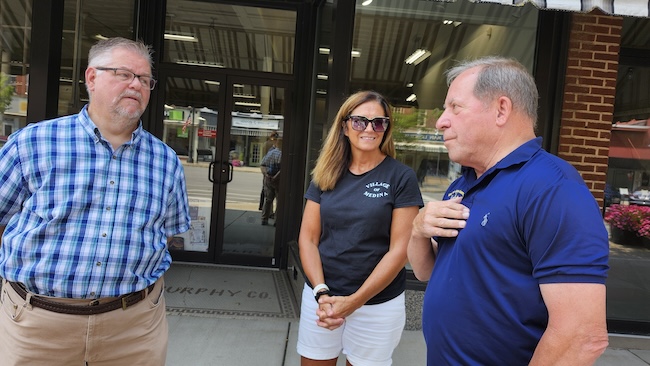
Chris Busch, left, president of Orleans Renaissance Group, talks with Medina Mayor Marguerite Sherman and Assemblyman Steve Hawley while waiting to dedicate in interpretive panel with Senator Rob Ortt, detailing Medina’s involvement in the Underground Railroad. Busch was instrumental in efforts to create the panel and obtain funding from the legislators.
The website explains how Busch, while researching another project in 2017, noticed a reference to Medina and the Underground Railroad quoted in a multi-volume history of the Civil War by Allan Nevins, entitled The Ordeal of the Nation. It revealed a footnote for the reference, noting the letter published in the New York Tribune.
By locating the letter in the Tribune, Busch uncovered the first known published testimonial by a resident of Medina regarding the community’s role in the Underground Railroad.
“This was a really cool discovery,” Busch said Monday.
He contacted State Senator Rob Ortt and Assemblyman Steve Hawley, asking if they could help with funding the 14th interpretive panel documenting Medina’s involvement in the Underground Railroad.
“My grandparents’ home in Warsaw was part of the Underground Railroad,” Hawley said. “I jumped at the chance to talk about it. My family has a history of supporting freedom.”
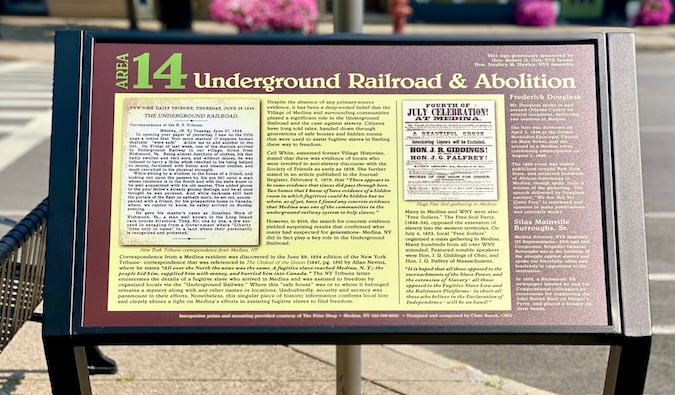
The new interpretive panel is the 14th in Medina about local history.
“When Busch contacted me and asked if we had the ability to help, I thought it was a worthy thing,” Ortt said. “For the amount of $1,000, split 50/50, I said, ‘Let’s do it.’ Steve and I both looked at it and wanted to help make it happen. I am well versed in the role other parts of my district played,” he added, citing Niagara Falls and the Underground Railroad Museum.
“There is an uptick of people coming here to Medina and they should know about things like this,” Ortt said. “It’s important to show them your history. I’m standing here where Frederick Douglass made a speech, and that’s a great thing.”
“Medina should be proud of what they have here,” Hawley said. “When I first got elected, I came to Medina. You have the opera house and fine restaurants. What you see in Medina is the envy of a lot of other counties.”
“The secret is we all work together and that’s important,” said Mayor Marguerite Sherman.
Ortt said a lot of villages along the canal maintained their old integrity.
“Medina said ‘no’ to urban renewal, and look at it now,” he said. “This is what people want.”
Looking up and down at Medina’s historic Main Street, Ortt said, “You couldn’t rebuild this in a million years.”
“This was all due to Chris,” Sherman said, pointing to the new panel, which he researched and designed.
Busch added his thanks to Jason Watts, superintendent of the Medina DPW and the DPW staff which did the installation, and the Print Shop, which fabricated the sign base and panel.




















































